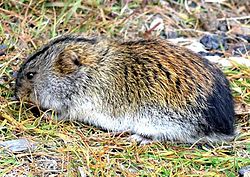Distribution
There are several disjunct populations; one is found from the Verkhoyansk Range east to the Kolyma River, including the New Siberian Islands; it is largely replaced by the Beringian lemming (L. nigripes) east of this region.
Another population is found south of the aforementioned northern population, being distributed from southern Yakutia and western Khabarovsk north to Magadan; this population was formerly classified as a subspecies of the Amur lemming, L. a. ognevi, or as its own distinct species, L. ognevi. Another population is found throughout most of the Kamchatka Peninsula (this population was also formerly classified as a subspecies of the Amur lemming, L. a. flavescens, or as its own distinct species, L. flavescens) although a disjunct population of L. nigripes is also present in the southern section of the peninsula. [1]
Finally, an isolated population is present on Wrangel Island. This population was previously included as a subspecies of L. sibiricus by Jarrell and Fredga in 1993, while Chernyavskii (also in 1993) regarded it as a separate species, L. portenkoi. However, phylogenetic studies support it being a population of L. paulus. [4]
This page is based on this
Wikipedia article Text is available under the
CC BY-SA 4.0 license; additional terms may apply.
Images, videos and audio are available under their respective licenses.
